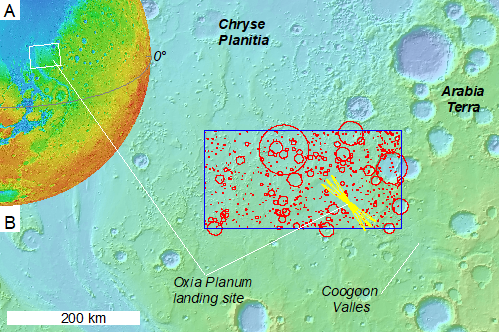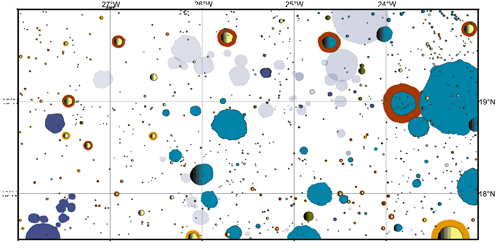Impact Crater Degradation and the Timing of Resurfacing events in Oxia Planum.
- 1School of Physical Sciences, The Open University, Walton hall, Milton Keynes, United Kingdom
- 2School of Earth and Environmental Sciences, University of St. Andrews, St Andrews, United Kingdom
Introduction: Oxia Planum (OP) will be the landing site of ‘Rosalind Franklin’ (RF), the ExoMars 2020 rover (Figure 1). With the primary goal of searching for signs of past and present life on Mars, the ExoMars rover will investigate the geochemical environment in the shallow subsurface over a nominal mission of 218 martian days (sols) [1]. Two science criteria for landing site selection were ancient terrains, representing the time at which Mars was at a peak of habitability, and a recent surface exposure age, minimizing cosmic ray bombardment and associated damage to organic biomarkers - key targets for Rosalind Franklin’s analytical instruments [1]. Oxia Planum contains ancient clay-bearing terrains and has undergone significant burial and erosion, with some terrains having been recently exposed, so it is an ideal site.
The landing site contains impact craters, the distribution, and degradation of which can tell us where and when burial and erosion processes have occurred. Here we: (1) Present an impact crater degradation classification scheme and database (Figure 2) [2]; (2) Report the likelihood of degradation morphologies occurring together; (3) Use the database to explore the timing of resurfacing events in OP, and; (4) Consider the implications for the geological evolution of the OP site and the wider Chryse/Arabia margin.

Figure 1: The location of Oxia Planum study area (blue square), the Exo-Mars landing site (yellow ellipses), impact craters (red).
Data: We developed a crater degradation classification scheme based on morphologies observable in 5–6 m/pixel CTX [3] and digitized on Murray Lab global CTX mosaic tiles; E028N16 and E024N16 [4]. We also used THEMIS [4] data overlain by the MOLA topography data to identify subtle relief patterns indicating buried “ghost craters”.
Methodology: All impact craters >500 m in diameter in the OP region (Figure 1) were recorded and classified. Classification is based on the deviation from a pristine morphology by post-impact burial and degradation processes in four aspects of their morphology: (1) Stratigraphic relationship, (2) cross-sectional shape, (3) crater rim morphology, and (4) ejecta morphology. From the database, we performed a quantitative analysis to assess the probability of different degradation morphologies occurring together using the open-source Anaconda Software Python/R data science packages. We used to use the Impact Crater Size Frequency Distributions (CSFD) of the different populations of craters, based on their ‘stratigraphic relationship’ criterion, to explore the timing of regional burial and erosion process events.

Figure 2: The distribution of impact craters in the Oxia Planum study area and the symbolization illustrating the 4 classes of degradation morphology.
Results: The classification shows that there is a generally consistent relationship between different morphological aspects of impact crater morphology as craters degrade, forming a general trend. The distribution of different degradation morphologies (Figure 2) highlights where different burial and erosion processes have occurred history of Oxia Planum.
To understand when these events happened we evaluated the CSFD for populations of craters with different degradation states (Figure 3). Craters that have not been infilled tell us the time since there has been substantial sedimentation and craters that retain sharp rims and do not have eroded ejecta tell use the time since there has been substantial regional erosion (Figure 4a). By considering buried craters, and those with removed rims embayed by younger terrain, we determine a minimum age of the basement (Figure 4b).
Figure 3: Cross-sections illustrating the time sequence of different classes within the ‘stratigraphy’ classification of impact craters [2].
Discussion & Conclusions: The model ages and distribution of impact craters with different states of burial and erosion suggest that different processes have occurred in OP at different times. Close inspection of the geological setting of these crater populations shows that:
(i) The ~4.0 Ga regional basement contains light-toned, layered, clay-bearing terrains. The light-toned surfaces host the most heavily degraded craters, and in the areas where craters have been buried, this is likely to be the underlying material in which the now buried craters formed. Furthermore, these impact craters are systematically found at lower elevations. Given the context of the study area, at the termination of a substantial ancient channel system (Coogoon Valles) into a very large basin (Chryse Planitia), we hypothesize that fluvial, lacustrine or possibly thalassic processes eroded and infilled these craters.
(ii) Although the depositional processes had stopped by ~3.5 Ga there was still widespread erosion, degradation, modifying the rims, and removing ejecta from craters. The bowl-shaped (not infilled) floors of those craters which still retain degraded ejecta suggest that all fluvial, or other heterogeneous depositional, activity in the region had ceased by this time.
(iii) All impact craters with sharp rims and preserved ejecta are younger than ~3.0 Ga. This suggests that since this time there have been substantially lower rates of erosion compared to the preceding ~0.5 Ga. This is consistent with global trends and implies that the removal of any regional overlying strata, such as might be represented by remnant rounded, buttes [6,7 ], occurred before this time.
Figure 4: The CSFD for impact craters which (a) overly the clay-bearing terrains and (b) underlay, or are found within, these clay-bearing units
Acknowledgment: The Open University’s ‘Space Strategic Research Area’ for funding A. Roberts’
References: [1] Vago, J. L. et., al. 2017 Astrobiology 17, 471–510. [2] Roberts et al., 2020 in prep, [3] Malin et al., (2006) [4] Dickson et al., 2018; (http://murray-lab.caltech.edu/CTX/index.html [5] Christensen et al., (2004) Space Science Reviews, 110,1 [6] Quantin-Nataf et al., 2020 in press at Astrobiology. [7] McNeil et al., 2020; This conference
How to cite: Fawdon, P., Roberts, A., and Mirino, M.: Impact Crater Degradation and the Timing of Resurfacing events in Oxia Planum., Europlanet Science Congress 2020, online, 21 September–9 Oct 2020, EPSC2020-55, https://doi.org/10.5194/epsc2020-55, 2020

